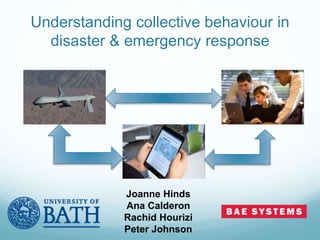
Understanding collective behaviour in disaster and emergency response
- 1. Understanding collective behaviour in disaster & emergency response Joanne Hinds Ana Calderon Rachid Hourizi Peter Johnson
- 2. What are Human-Autonomous Systems? • Collections of human and autonomous agents • Defense, disasters and emergency response, search and rescue, transport
- 3. Human-Autonomous Systems Collective Capability Current challenges Providing the right information to the right agent at the right time Overcoming inflexible, rule bound behaviour Quality and trustworthiness of decision-making Overall Aims: To enable multiple agencies (autonomous and human) to work together to increase the collective capability of the whole human-autonomous system To enable HAS to achieve their objective in a safe, agile and efficient manner
- 4. Studies Study 1: How do humans respond to dynamic events in a disaster? Study 2: How does a group attempt to solve a wicked problem?
- 5. Large-scale emergencies and crises Typically have: Decentralised response and rescue effort Volatile, unpredicatable, conflicting information Efforts are increasingly incorporating human and autonomous agents
- 6. The role of autonomous systems in emergencies Autonomous systems can help a variety of people in a variety of circumstances From official responders to locals on the ground
- 7. Study – Human Autonomous Systems in crisis Qualitative study Hurricane scenario 21 students/staff Bath University Emergency responder immersed in a HAS Commands and reports issued by: Issued by humans (trained responders or locals on the ground) or autonomous agents Co-located or remote Urgent or non-urgent
- 8. Addressing HAS Challenges Questions To what extent do agents follow commands and how flexible are they with execution? What information do agents seek/report and why? HAS Challenges Providing right information to the right agent at the right time Quality and trustworthiness Overcoming flexible, rule bound behaviour Properties of information Conflicting Uncertain Rapidly changing Rule bound
- 9. Scenario No.3 Couple Urgent No.2 1 elderly lady Urgent No. 1 Family of 4 Non- urgent No. 5 Family of 3 Urgent No. 4 Student house of 6 Non- urgent No. 6 Flats 30 residents disabled Urgent No. 8 Shop Family of 8 Non- urgent No. 10 Couple Non- urgent No. 7 – Offices 30 people Urgent No.9 1 resident Non- urgent Drop-off point
- 10. Commands Injured and disabled people are prioritised for evacuation Only evacuate people classified as “urgent” Evacuate buildings with the highest numbers of people first Always fill the boat to full capacity before returning to the drop-off point Provide regular reports (updates) to your collaborators so they can coordinate their actions and respond most effectively.
- 11. Findings Thematic analysis Commands Integration Compliance with original commands Reports Reprioritisation Compliance with original commands Clarification
- 12. Findings - Command Compliance with original commands – “Return to the drop-off point” (Non-urgent) “If it’s from my supervisor…. I could maybe look for 10 minutes so I still may not go immediately, I might see what the situation was. If I could get them in the boat quickly I would, so I would go against direct orders a little bit but I would make my way back to the drop off point quickly.” “Ignore it, because it is non- urgent.”
- 13. Findings - Report Clarification – “Entrance to no. 8 is blocked” (Non- urgent) “I would send for the UAV to check and see what it is because it doesn’t look like high priority so if it checks, I can keep going with what I’m doing. I’ll wait for the report and then I can reprioritise if necessary.” Reprioritisation – “There is a distressed cry for help from house no.2” (Urgent) “I could pick her up on one of my trips, if I just get three and then get one….Yeah, I’ll take 3 instead and then pick her up on the way.”
- 14. Conclusions Responders utilised autonomous systems to aid their workload through delegation and clarification Behaviour was rule bound, yet there was some flexibility Dynamic events influenced trustworthiness
- 15. Work in Progress: Study 2 Wicked problem solving – “in the wild” Members of the collective: Searching for information Sharing information Cryptic tasks and clues HAS Challenges Timing of information Quality/trustworthiness Flexibility
- 16. Summary Autonomous systems are improving collective capability Emergency response and wicked problems Addressing HAS challenges (timing of information, flexibility, quality) by exploring decision making, information exchange and rationales Aiming to make HAS more efficient, safe and agile
- 17. Thank you
Editor's Notes
- No longer working with passive computers, telling them what to do – now working alongside us. AS can work intelligently and independently. Work is geared towards collecitves – comprising humans and AS How to harness and coordinate the endeavours of HAS. Social interactions that are flexible Different constellations of people, resources and info need to come together, operate in a coordinated fashion then disband. Agents need to coordiante flexibly – flexible autonomy Agile teaming – come together ad hoc to achieve joint goals then disband Failures, ineffectiveness and inefficiency costs resources and lives In the wild….
- Ability to exploit and learn from information
- Autonomous drone – for positioning and detection